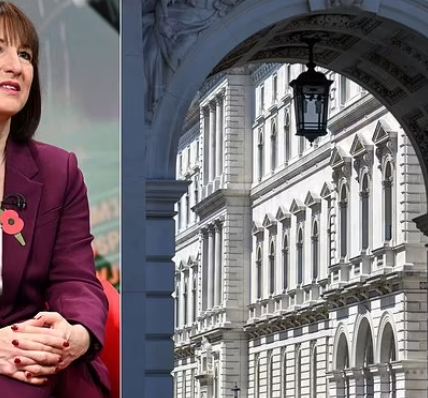England and Wales’s most dangerous streets: Map of 37,000 neighbourhoods lays bare hotspots for violent and sexual offences… so how crime-ridden is YOUR district?_Nhy
Birmingham‘s New Street is the most crime-ridden neighbourhood in England and Wales, MailOnline can today reveal.
The equivalent of nearly five people in that tiny zone of Ladywood – an inner-city district home to the city’s main transport hub – were attacked, raped or sexually assaulted every day in 2024.
Our analysis of crime rates in all 37,000 neighbourhoods is available to view in an interactive map.
It comes with Britain gripped by a crime epidemic. Labour is under pressure to get tougher on offenders to stop rates spiralling and avoid triggering a backlash among working class voters desperate for a crackdown.
More than 2.2million violent or sexual crimes reported to police across 2023/24 in England and Wales, according to Government figures.
It marked one of the worst years on record, with reports of crimes such as assault, GBH, murder, rape and sexual assault having tripled over the last decade.
Powered with official statistics, our map breaks down crime rates by ‘Lower layer Super Output Areas’ (LSOAs) — communities consisting of around 500 to 1,500 people.
Each neighbourhood is ranked by offences per 1,000 population, allowing you to see where the hotspots are. The darker the red, the higher the crime rate. To find your area, select your local police force from the drop-down list and zoom into wherever you want to search.
By tapping or hovering over the area, you can also see the total number of violent or sexual offences logged, as well as the crime density (reports per square mile).
No map is available for Greater Manchester Police because the force has not updated its section of the national crime database since July 2019. The maps also excludes crimes committed on trains or at train stations as they are dealt with by the British Transport Police, rather than the local force.
The figures include all alleged crimes which are reported to the police and given a crime number, regardless of the outcome of any investigation.
The pop-ups are named by the electoral ward which covers the neighbourhood and the local authority, meaning neighbouring areas may appear with the same name but have different statistics. That is because each ward may have numerous LSOAs.
Within Birmingham, for example, there are 15 instances of Ladywood, although only one covers New Street Station. That district, technically called E01033620, is the violent crime capital.
Some 1,782 violent or sexual crimes were committed in that one-fifth of a square mile area throughout 2024, data analysed by MailOnline shows.
This equates to around 8,500 violent crimes per square mile in the area patrolled by West Midlands Police.
When compared with its more than 1,200 population, this gives a crime rate of 1,441 per 1,000 residents — more than double that of the second-worst neighbourhood in England and Wales, an area in Doncaster (766 per 1,000 residents).

Police at the scene in Birmingham’s Victoria Square where 17-year-old Muhammed Ali was stabbed to death on January 20, 2024 by a 15-year-old boy who was egged on by his friend, also 15


Muhammad was taken to Birmingham’s Queen Elizabeth Hospital, but the damage to his heart was too severe and he was pronounced dead at around 6.40pm
Areas with high footfall compared to their population, such as industrial, retail and transport hubs, typically have inflated crime rates because locations are recorded as where the crime occurred, rather than the victim’s or perpetrator’s home address.
Teenager Muhammad Ali was murdered in Victoria Square, in the Birmingham New Street crime hotspot, on January 20 last year.
In November, two 15-year-old boys, who cannot be named for legal reasons were were sentenced with for killing ‘clever’ and ‘kind’ 17-year-old, one for murder, the other with manslaughter.
The murderer was sentenced to at least 13 years behind bars, his friend to five years.
Muhammad and a friend had arranged to meet up in the city centre at around 2.30pm. They met up in the Little Dessert shop in the Bullring before heading towards Victoria Square, where they sat next to the Floozie in the Jacuzzi.
They were unaware that they had been followed by two 15-year-old boys who were preparing to confront them.
The pair confronted Muhammad and his friend, demanding to know where they were from and if they were responsible for an earlier attack on one of their friends. They were not.
The pair continued to quiz Muhammad and his friend, until Muhammad told the pair to go away because he didn’t know what they were talking about.
At that, one of the boys suddenly pulled out a large knife and stabbed him in the chest before fleeing.

Police at the scene on Hall Gate in Doncaster near were Janis Kozlovskis, 17, and Ryan Theobald, 20, were stabbed to death on January 29, 2022



Ryan Theobald (left), 20, and Janis Kozlovskis (centre), 17, were murdered Amrit Jhagra (right), in Doncaster city centre
Muhammad, who dreamed of becoming and engineer, was taken to Birmingham’s Queen Elizabeth Hospital, but the damage to his heart was too severe and he was pronounced dead at around 6.40pm.
In Britain’s number two crime hotspot in Doncaster city centre, Janis Kozlovskis, 17, and Ryan Theobald, 20, were stabbed to death on January 29, 2022.
Teenager Amrit Jhagra, 19, was found guilty of their murders in July of that year and later sentenced to life with a minimum of 26 years behind bars after his original 24-year sentence was deemed ‘unduly lenient’.
A fight began between Janis and a friend of the defendant, Amrit Jhagra, which carried on as they moved on from a bar outside Silver Street at 2.30am.
A few moments later, Ryan ended up in the midst of the altercation. As they reached the corner of Silver Street and High Street, CCTV footage shows that Ryan was approached by Jhagra, who stabbed him and left him lying in the street. As Janis moved down the street he was pursued by Jhagra, who pulled him to the ground and stabbed him multiple times before fleeing the scene.
The neighbourhood containing Leicester Square, in the City of Westminster, is ranked third, with a crime rate of 716 per 1,000 residents.
A schoolgirl, 11 and her mother, 34 were rushed to hospital after they were stabbed in Leicester Square on August 12 last year in broad daylight.
A man has been charged with attempted murder in connection with the alleged attack.
It is followed by a neighbourhood within Newcastle upon Tyne city centre (669) and then the tourist hotspot of Brighton Beach – the stretch containing the i360 viewing deck has a rate of 664 per 1,000 residents. The famous pier, however, is in the neighbouring geographical area.
A total of 6,319 out of more than 37,000 LSOAs – 17 per cent – have violent crime rates of more than 50 per 1,000 residents. This is the equivalent of one in twenty residents reporting a crime.
Just 26 LSOAs have violent crime rates of effectively zero, including an area just a short walk from the centre of Hertfordshire town Harpenden, which includes the Crabtree Primary school.
An area of Rural West York, containing the quaint villages of Upper and Nether Poppleton, experienced just one report of a violent or sexual crime in 2024.
The eastern half of the Chiltern Park estate which borders Berkhamsted Castle, in Hertfordshire, saw zero violent crimes amongst its 1,348 population last year. The area also contains the Bridgewater Primary School and backs on to the idyllic Chiltern Hills.
Home Secretary Yvette Cooper vowed to halve knife crime by the end of 2034 in her speech to Labour conference last September.
She said the Government would ban the sale of ninja and samurai swords, while paying tribute to Pooja Kanda, whose 16-year-old son Ronan was stabbed to death with a ninja knife in Wolverhampton in 2022.
The Labour minister said she would ban repeat anti-social offenders from town centres with new ‘respect orders’.
She also wants to bring in 13,000 new police officers and bring more bobbies back on the beat.


